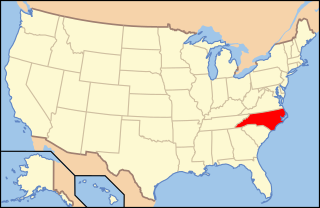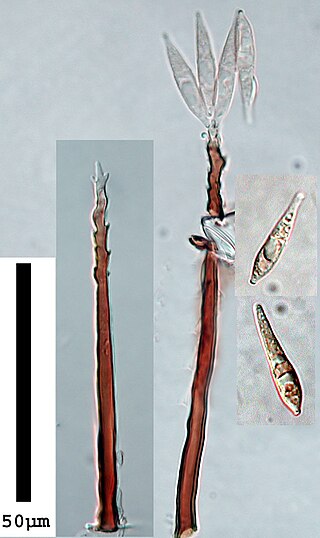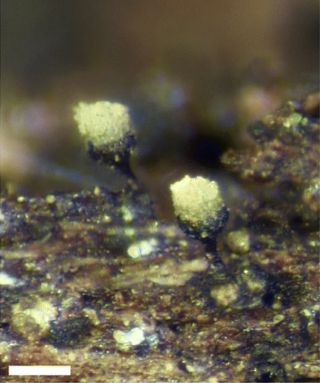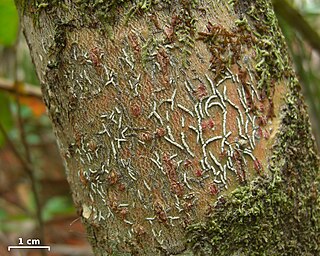
Cochliobolus carbonum is one of more than 40 species of filamentous ascomycetes belonging to the genus Cochliobolus. This pathogen has a worldwide distribution, with reports from Australia, Brazil, Cambodia, Canada, China, Congo, Denmark, Egypt, India, Kenya, New Zealand, Nigeria, Solomon Islands, and the United States. Cochliobolus carbonum is one of the most aggressive members of this genus infecting sorghum, corn and apple. As one of the most devastating pathogens of sweet corn, C. carbonum causes Northern leaf spot and ear rot disease while the asexual stage causes Helminthosporium corn leaf spot. Cochliobolus carbonum is pathogenic to all organs of the corn plant including root, stalk, ear, kernel, and sheath. However, symptoms of infection show distinct manifestations in different plant parts: whole plant - seedling blight affects the whole plant, leaf discoloration and mycelial growth, black fungal spores and lesions appear on inflorescences and glumes, and grain covered with very dark brown to black mycelium which gives a characteristic charcoal appearance due to the production of conidia.

The Pertusariales are an order of fungi in the class Lecanoromycetes, comprising 8 families, 31 genera, and over 600 species, many of which form lichens. This diverse group is characterized by complex taxonomic history and ongoing phylogenetic revisions. Originally circumscribed by lichenologists David L. Hawksworth and Ove Eriksson in 1986, Pertusariales has undergone significant reclassification due to molecular phylogenetics studies. The order includes well-known genera such as Pertusaria and Ochrolechia, as well as families like Megasporaceae and Icmadophilaceae.
Aquamarina is a fungal genus in the class Dothideomycetes. It is a monotypic genus, containing the single marine species Aquamarina speciosa, originally found in North Carolina, and distributed in the Atlantic Coast of the United States. The bluish-green species fruits exclusively in the lower parts of dying culms of the saltmarsh plant Juncus roemerianus.
Aphanopsidaceae is a family of lichen-forming fungi in the order Lecanorales. It contains the genera Aphanopsis and Steinia, comprising five species. The family was circumscribed in 1995 by the lichenologists Christian Printzen and Gerhard Rambold.

Architrypethelium is a genus of lichen-forming fungi in the family Trypetheliaceae.
The Loramycetaceae are a family of fungi in the Ascomycota, class Leotiomycetes. This is a monotypic taxon, containing the single genus Loramyces; the genus contains two aquatic species, L. juncicola, named by American mycologist William H. Weston in 1929, and L. macrosporus, first described by C.T. Ingold and B. Chapman in 1952.
Massarina carolinensis is a species of fungus in the Lophiostomataceae family. The species is found exclusively on the lower parts of the culms of the saltmarsh Juncus roemerianus on the Atlantic Coast of North Carolina.

Paraphaeosphaeria pilleata is a species of fungus in the Lophiostomataceae family. The species fruits exclusively in the lower parts of the culms of the black needlerush. It is found on the Atlantic Coast of North Carolina.

Hypocreopsis rhododendri is an ascomycete fungus. It is commonly known as hazel gloves due to the resemblance of it's orange-brown, radiating lobular ascocarp to rubber gloves, and because it is found on hazel stems.

Hypocreopsis amplectens is part of the family Hypocreaceae and genus Hypocreopsis, a group of fungi that form ascomata on the stems of trees and shrubs. The ascomata are orange-brown and consist of radiating, perithecial lobes. This species of Hypocreopsis was only discovered in 1992 in Nyora (Victoria) during a botanical survey.
Thielavia subthermophila is a ubiquitous, filamentous fungus that is a member of the phylum Ascomycota and order Sordariales. Known to be found on plants of arid environments, it is an endophyte with thermophilic properties, and possesses dense, pigmented mycelium. Thielavia subthermophila has rarely been identified as a human pathogen, with a small number of clinical cases including ocular and brain infections. For treatment, antifungal drugs such as amphotericin B have been used topically or intravenously, depending upon the condition.

The Pyriculariaceae are a family of ascomycete fungi in the order Magnaporthales. It was introduced by S. Klaubauf, M.H. Lebrun & P.W. Crous in 2014.
Collariella bostrychodes is a fungal decomposer of lignin and carbohydrate in the family Chaetomiaceae commonly found in soil and dung. The fungus is distinguished by a darkened collar-like ostiole around the ostiolar pore, giving the fungus its name. The fungus is highly variable in shape and form, giving raise to the belief that there are two subclades in the species. The ascospores range from lemon-shaped to nearly spherical with slightly pointed ends. It can grow to be pale green and later turn pale bluish grey or olivaceous with age. The fungus produces the toxic secondary metabolite, chaetochromin.
Botryotrichum piluliferum is a fungal species first identified in 1885 by Saccardo and Marchal. It was discovered to be the asexual state of a member of the ascomycete genus, Chaetomium. The name B. piluliferum now applies to the fungus in all its states. B. piluliferum has been found worldwide in a wide range of habitats such as animal dung and vegetation. The colonies of this fungus start off white and grow rapidly to a brown colour. The conidia are smooth and white. B. piluliferum grows optimally at a temperature of 25–30 °C and a pH of 5.5.

Myxotrichum chartarum is a psychrophilic and cellulolytic fungus first discovered in Germany by Gustav Kunze in 1823. Its classification has changed many times over its history to better reflect the information available at the time. Currently, M. chartarum is known to be an ascomycete surrounded by a gymnothecium composed of ornate spines and releases asexual ascospores. The presence of cellulolytic processes are common in fungi within the family Myxotrichaceae. M. chartarum is one of many Myxotrichum species known to degrade paper and paper products. Evidence of M. chartarum "red spot" mold formation, especially on old books, can be found globally. As a result, this fungal species and other cellulolytic molds are endangering old works of art and books. Currently, there is no evidence that suggests that species within the family Myxotrichaceae are pathogenic.

Allocalicium is a single-species fungal genus in the family Caliciaceae. It is monotypic, containing the single pin lichen species Allocalicium adaequatum. This lichen occurs in North America, South America, Europe, and the Russian Far East, where it grows on branches and twigs of deciduous trees and shrubs, typically those of alder and poplar. The species was originally described in 1869 as a member of Calicium, but molecular phylogenetics analysis demonstrated it was not a member of that genus and so Allocalicium was created to contain it.

Cryptocalicium is a single-species fungal genus of the order Eurotiomycetes that was circumscribed in 2021. It contains the species Cryptocalicium blascoi. Cryptocalicium is the only genus in the monotypic family Cryptocaliciaceae, the order Cryptocaliciales and the subclass Cryptocaliciomycetidae.
Paratopeliopsis is a single-species fungal genus in the family Graphidaceae. It contains the species Paratopeliopsis caraibica, a corticolous (bark-dwelling), leprose lichen found in Puerto Rico's forests, where it cohabits with mosses on tree trunks. This lichen sets itself apart from other species in the tribe Thelotremateae, particularly those within the genus Topeliopsis, primarily due to its flour-like thallus and its comparatively small, brown spores.

Dyplolabia afzelii is a species of corticolous (bark-dwelling), script lichen in the family Graphidaceae. It has a pantropical distribution. The lichen has a thallus with colours ranging from yellow to pale olive buff, dark brownish tan, or grey, characterised by its smooth texture and considerable thickness. Its ascomata are lirelline, often raised from the thallus surface and concealed under a powdery white layer.

Hypocreopsis lichenoides is part of the family Hypocreaceae and genus Hypocreopsis, a group of fungi that form ascomata on the stems of trees and shrubs. The ascomata are orange-brown and consist of radiating, perithecial lobes. It is commonly known as willow gloves due to the resemblance of the ascocarp to rubber gloves, and because it is usually found on willow trees.












